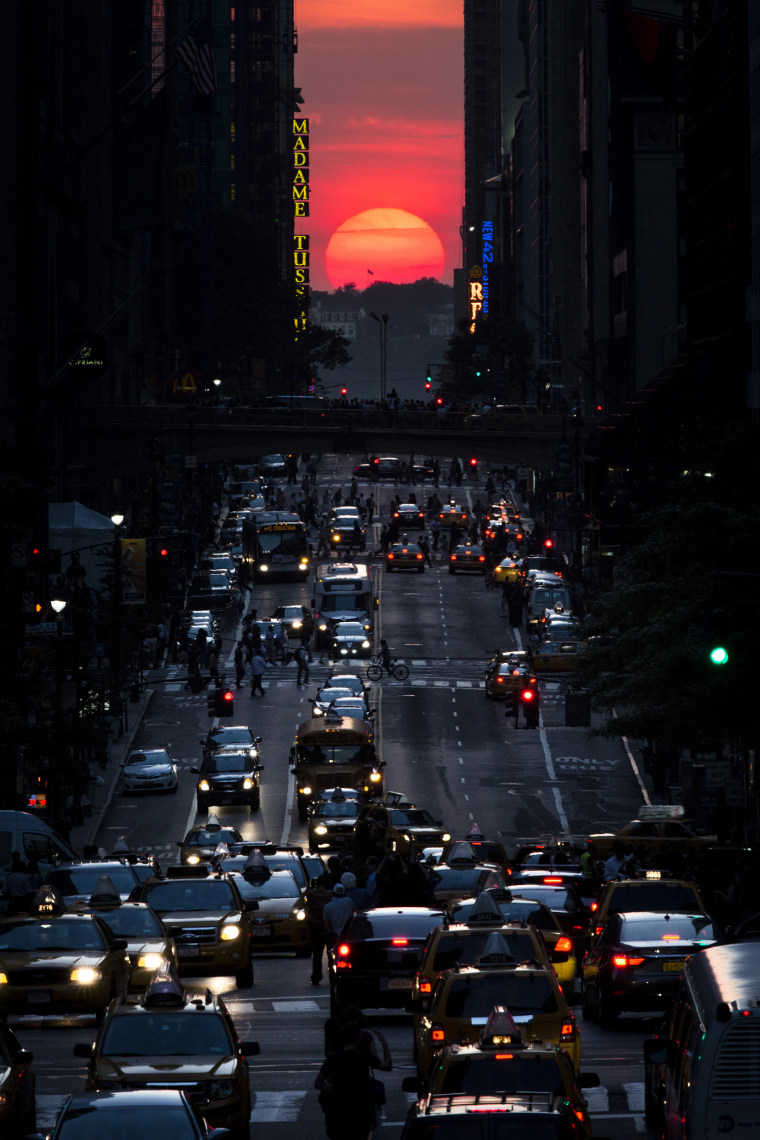Sunsets in New York City are extra special on four days out of every year, when — weather permitting — the glowing disc of the setting sun lines up with the deep canyons of buildings along Manhattan's streets to create a phenomenon known as Manhattanhenge.
"It's a beautiful and lucky coincidence that Manhattan is aligned the way that it is," Jackie Faherty, an astrophysicist at the American Museum of Natural History in New York City, told NBC News MACH in an email. "The luck is that the long part of the island of Manhattan goes roughly north-south...and the cross streets run east-west."
The first day of Manhattanhenge for 2018 is today, May 29, when the sun sets at 8:13 p.m EDT on a sunny day. The other dates and times for Manhattanhenge this year at 8:12 p.m. EDT tomorrow, on a day forecast to be party cloudy; Thursday, July 12 at 8:20 EDT; and Friday, July 13 at 8:21 EDT.
Today and July 13 are so-called "half-sun" days, meaning that the sun's upper half is visible against the horizon at sunset. Tomorrow and July 12 are "full-sun" days, on which the full disk of the sun is visible.
The best places to view Manhattanhenge are along the Big Apple's major east-west thoroughfares, including 14th, 34th, 57th, and 79th Streets. Experts recommend positioning yourself as far east in Manhattan as possible — just make sure you're still able to see New Jersey as you look to the west.
If Manhattan's streets lined up perfectly with the compass directions, Manhattanhenge would occur precisely on the first day of spring and summer, according to a post on the museum's website by Faherty's colleague Neil deGrasse Tyson. But Manhattan's street grid is rotated 30 degrees east from geographic north, so Manhattanhenge's dates are shifted to the dates listed above.

Though Manhattanhenge occurs because of the fortuitous orientation of the Big Apple's street grid, it's ultimately Earth's particular orbital path around the sun that makes the phenomenon possible.
"Earth is tilted by 23.5 degrees from the plane of the sun," Faherty says. "Consequently, as the Earth traverses its long, 365-day ride around the sun, one would notice that the sun appears to rise and set at a different position on the horizon throughout the year. Any grid facing east-west has the potential of creating a bulls-eye for the sun to land upon."
Tyson coined the word Manhattanhenge in a nod to Stonehenge, the prehistoric monument on England's Salisbury Plain about 90 miles west of London. That site is oriented such that sunlight hits its tall stones in special patterns on the summer and winter solstices.
Want more?